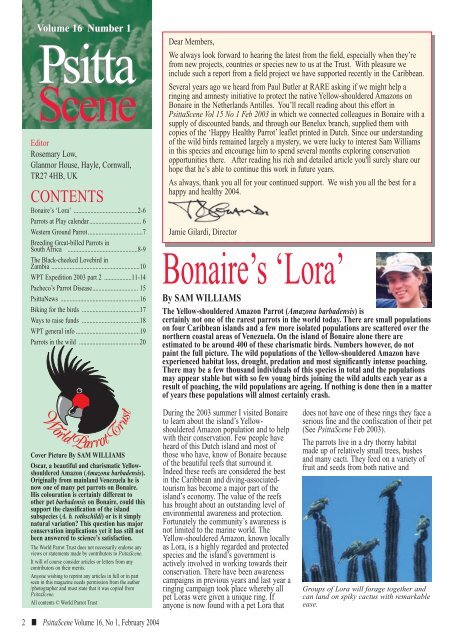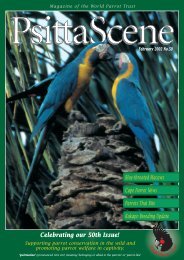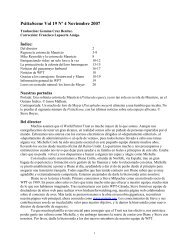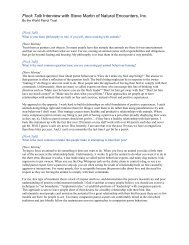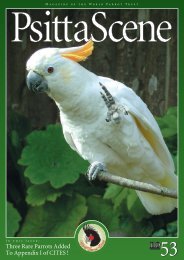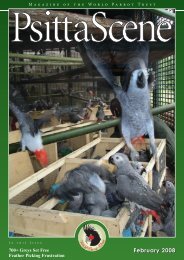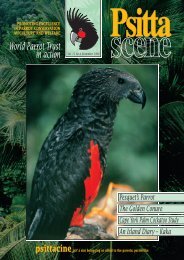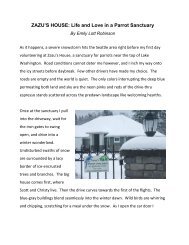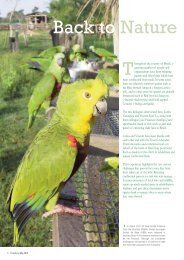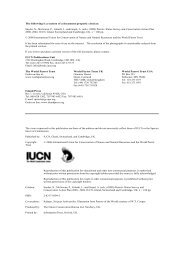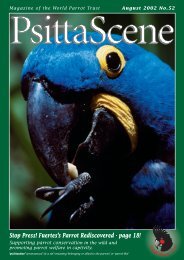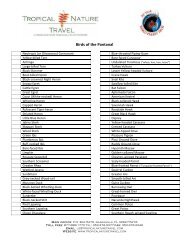February 2004 - World Parrot Trust
February 2004 - World Parrot Trust
February 2004 - World Parrot Trust
Create successful ePaper yourself
Turn your PDF publications into a flip-book with our unique Google optimized e-Paper software.
Volume 16 Number 1<br />
Psitta<br />
Scene<br />
Editor<br />
Rosemary Low,<br />
Glanmor House, Hayle, Cornwall,<br />
TR27 4HB, UK<br />
CONTENTS<br />
Bonaire’s ‘Lora’ ..........................................2-6<br />
<strong>Parrot</strong>s at Play calendar.................................. 6<br />
Western Ground <strong>Parrot</strong> ....................................7<br />
Breeding Great-billed <strong>Parrot</strong>s in<br />
South Africa ..............................................8-9<br />
The Black-cheeked Lovebird in<br />
Zambia ..........................................................10<br />
WPT Expedition 2003 part 2 ..................11-14<br />
Pacheco’s <strong>Parrot</strong> Disease.............................. 15<br />
PsittaNews ....................................................16<br />
Biking for the birds ......................................17<br />
Ways to raise funds ......................................18<br />
WPT general info ..........................................19<br />
<strong>Parrot</strong>s in the wild ........................................20<br />
Dear Members,<br />
We always look forward to hearing the latest from the field, especially when they’re<br />
from new projects, countries or species new to us at the <strong>Trust</strong>. With pleasure we<br />
include such a report from a field project we have supported recently in the Caribbean.<br />
Several years ago we heard from Paul Butler at RARE asking if we might help a<br />
ringing and amnesty initiative to protect the native Yellow-shouldered Amazons on<br />
Bonaire in the Netherlands Antilles. You’ll recall reading about this effort in<br />
PsittaScene Vol 15 No 1 Feb 2003 in which we connected colleagues in Bonaire with a<br />
supply of discounted bands, and through our Benelux branch, supplied them with<br />
copies of the ‘Happy Healthy <strong>Parrot</strong>’ leaflet printed in Dutch. Since our understanding<br />
of the wild birds remained largely a mystery, we were lucky to interest Sam Williams<br />
in this species and encourage him to spend several months exploring conservation<br />
opportunities there. After reading his rich and detailed article you'll surely share our<br />
hope that he’s able to continue this work in future years.<br />
As always, thank you all for your continued support. We wish you all the best for a<br />
happy and healthy <strong>2004</strong>.<br />
Jamie Gilardi, Director<br />
Bonaire’s ‘Lora’<br />
By SAM WILLIAMS<br />
The Yellow-shouldered Amazon <strong>Parrot</strong> (Amazona barbadensis) is<br />
certainly not one of the rarest parrots in the world today. There are small populations<br />
on four Caribbean islands and a few more isolated populations are scattered over the<br />
northern coastal areas of Venezuela. On the island of Bonaire alone there are<br />
estimated to be around 400 of these charismatic birds. Numbers however, do not<br />
paint the full picture. The wild populations of the Yellow-shouldered Amazon have<br />
experienced habitat loss, drought, predation and most significantly intense poaching.<br />
There may be a few thousand individuals of this species in total and the populations<br />
may appear stable but with so few young birds joining the wild adults each year as a<br />
result of poaching, the wild populations are ageing. If nothing is done then in a matter<br />
of years these populations will almost certainly crash.<br />
Cover Picture By SAM WILLIAMS<br />
Oscar, a beautiful and charismatic Yellowshouldered<br />
Amazon (Amazona barbadensis).<br />
Originally from mainland Venezuela he is<br />
now one of many pet parrots on Bonaire.<br />
His colouration is certainly different to<br />
other pet barbadensis on Bonaire, could this<br />
support the classification of the island<br />
subspecies (A. b. rothschildi) or is it simply<br />
natural variation? This question has major<br />
conservation implications yet it has still not<br />
been answered to science’s satisfaction.<br />
The <strong>World</strong> <strong>Parrot</strong> <strong>Trust</strong> does not necessarily endorse any<br />
views or statements made by contributors to PsittaScene.<br />
It will of course consider articles or letters from any<br />
contributors on their merits.<br />
Anyone wishing to reprint any articles in full or in part<br />
seen in this magazine needs permission from the author<br />
/photographer and must state that it was copied from<br />
PsittaScene.<br />
All contents © <strong>World</strong> <strong>Parrot</strong> <strong>Trust</strong><br />
2 ■ PsittaScene Volume 16, No 1, <strong>February</strong> <strong>2004</strong><br />
During the 2003 summer I visited Bonaire<br />
to learn about the island’s Yellowshouldered<br />
Amazon population and to help<br />
with their conservation. Few people have<br />
heard of this Dutch island and most of<br />
those who have, know of Bonaire because<br />
of the beautiful reefs that surround it.<br />
Indeed these reefs are considered the best<br />
in the Caribbean and diving-associatedtourism<br />
has become a major part of the<br />
island’s economy. The value of the reefs<br />
has brought about an outstanding level of<br />
environmental awareness and protection.<br />
Fortunately the community’s awareness is<br />
not limited to the marine world. The<br />
Yellow-shouldered Amazon, known locally<br />
as Lora, is a highly regarded and protected<br />
species and the island’s government is<br />
actively involved in working towards their<br />
conservation. There have been awareness<br />
campaigns in previous years and last year a<br />
ringing campaign took place whereby all<br />
pet Loras were given a unique ring. If<br />
anyone is now found with a pet Lora that<br />
does not have one of these rings they face a<br />
serious fine and the confiscation of their pet<br />
(See PsittaScene Feb 2003).<br />
The parrots live in a dry thorny habitat<br />
made up of relatively small trees, bushes<br />
and many cacti. They feed on a variety of<br />
fruit and seeds from both native and<br />
Groups of Lora will forage together and<br />
can land on spiky cactus with remarkable<br />
ease.


